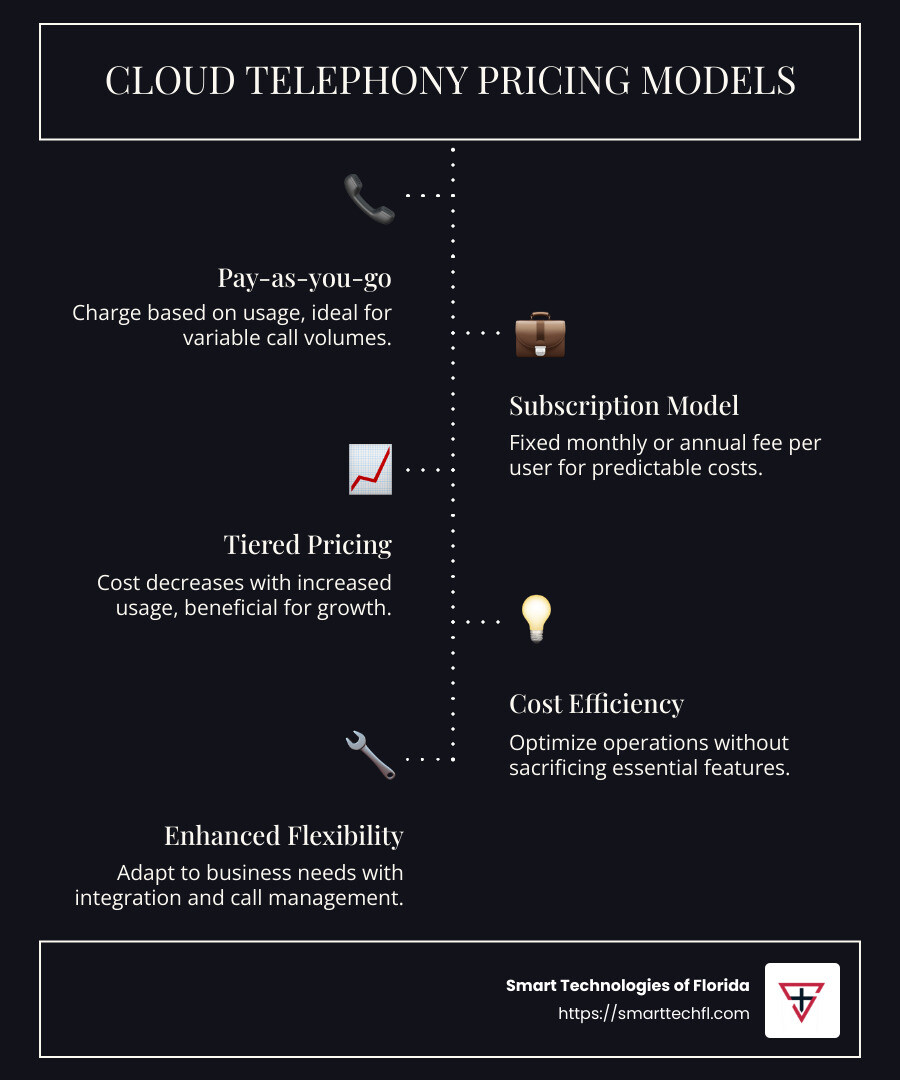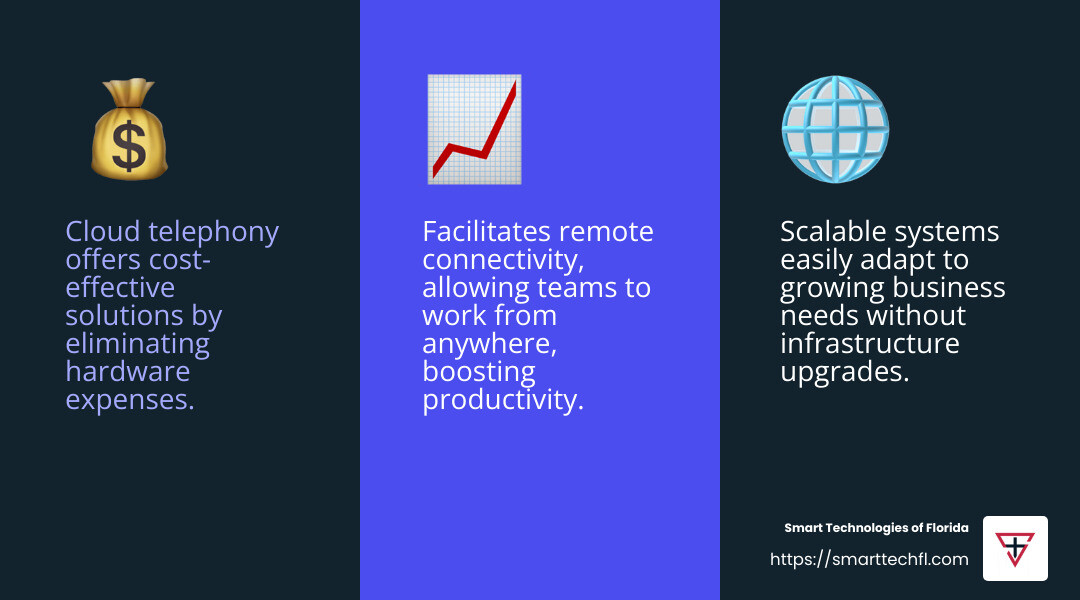Cloud Telephony Pricing: Finding the Best Value
Cloud telephony pricing can vary significantly, making it crucial for businesses to understand what they are paying for. On average, businesses can expect prices to range from $15 to $50 per user per month, depending on the features and level of service required.
Cloud telephony, also known as internet telephony or Voice over Internet Protocol (VoIP), transforms how businesses communicate. Unlike traditional landlines, cloud telephony operates over the internet, providing businesses with greater flexibility and cost efficiency. The pricing structures for these services are diverse and usually fall into one of three models:
- Pay-as-you-go – You’re charged based on usage, commonly favored by businesses with fluctuating call volumes.
- Subscription model – A monthly or annual fee per user, popular among businesses seeking predictable costs.
- Tiered pricing – Costs decrease as your usage volume increases, beneficial for growing businesses.
With these models, businesses can find a plan that best suits their budget and operational needs without sacrificing essential features like call management, security, and integration capabilities. Understanding these price models helps businesses like mid-sized retail shops make informed decisions, leading to reduced operational costs and improved communication capabilities.

Understanding Cloud Telephony
Cloud telephony, also known as internet telephony or Voice over Internet Protocol (VoIP), is a modern communication solution that operates over the internet. It replaces traditional landline systems with a more flexible and cost-effective alternative.
What makes cloud telephony so appealing? Let’s break it down:
Benefits of Cloud Telephony
- Cost-Effective: Cloud telephony eliminates the need for expensive hardware and maintenance. Businesses save money on setup and operational costs. You only pay for what you use, making it a budget-friendly option for companies of all sizes.
- Scalability: As your business grows, so can your phone system. Adding new users or features is simple and doesn’t require additional infrastructure. This flexibility is particularly beneficial for businesses with fluctuating needs.
- Remote Connectivity: Teams can connect from anywhere, anytime. This is ideal for businesses with remote employees or multiple locations. It ensures everyone stays connected, enhancing productivity and collaboration.
- Advanced Features: Cloud telephony offers a range of features like call forwarding, voicemail, and video conferencing. These tools improve communication efficiency and customer service.
- Disaster Recovery: In case of emergencies, cloud telephony systems can reroute calls and save data, ensuring business continuity. This built-in resilience is crucial for maintaining operations during unforeseen events.

Cost-Effective Communication
Traditional phone systems often come with hidden costs and limitations. Cloud telephony, on the other hand, offers transparent pricing and a host of features without breaking the bank.
- Pay-as-you-go: Perfect for businesses with variable call volumes. You pay for the minutes you use, avoiding unnecessary expenses.
- Subscription Model: Provides a fixed monthly fee, allowing for predictable budgeting. This is ideal for businesses that prefer stability in their expenses.
- Tiered Pricing: As usage increases, the cost per user decreases. This model supports growth and encourages businesses to expand their communication capabilities.
Cloud telephony is not just about making calls; it’s about changing how businesses communicate. By switching to cloud telephony, companies can enjoy improved functionality, greater flexibility, and significant cost savings.

Understanding these benefits and pricing models empowers businesses to make informed decisions, ensuring they choose a solution that aligns with both their budget and operational goals.
Next, we’ll dig deeper into the key factors affecting cloud telephony price to help you find the best value for your business needs.
Cloud Telephony Price: Key Factors
When considering cloud telephony price, there are several key factors that businesses should keep in mind. Understanding these factors helps in selecting the right plan that aligns with your needs and budget. Let’s explore the primary pricing models: usage-based and pay-as-you-go.
Pricing Models
- Usage-Based Pricing:
- This model charges based on the actual usage of the telephony services. It’s ideal for businesses with fluctuating call volumes.
- Costs are calculated on minutes used, messages sent, or data consumed.
- For example, Amazon Connect charges $0.004 per message for chat usage and $0.01 per message for SMS, allowing businesses to pay only for what they use.
- Pay-As-You-Go:
- Offers flexibility without long-term commitments. You pay for services on an as-needed basis.
- This model is perfect for businesses that anticipate variable needs or are just starting out and want to avoid upfront costs.
- It includes charges for inbound and outbound calls, making it easy to manage expenses based on actual usage.
Finding the Best Value
- Scalability: As your business grows, your telephony needs might change. A scalable plan ensures that you can add or remove features without incurring significant costs.
- Advanced Features: Consider plans that offer additional features like call forwarding, voicemail, and video conferencing. These can improve productivity and customer service.
- Transparency: Look for providers that offer clear pricing structures with no hidden fees. This helps in maintaining a predictable budget.
By understanding these key factors and pricing models, businesses can make informed decisions about which cloud telephony solution offers the best value.
In the next section, we will compare different cloud telephony pricing plans to help you determine which option fits your business needs.
Comparing Cloud Telephony Pricing Plans
When it comes to selecting a cloud telephony plan, understanding the differences between the Professional and Enterprise plans is crucial. These plans vary in features and monthly fees, catering to different business sizes and communication needs.
Professional Plan
The Professional plan is designed for small to medium-sized businesses. It often includes:
- Basic Features: Unlimited domestic calling, SMS capabilities, and standard call management features.
- Monthly Fees: Typically lower than the Enterprise plan, making it cost-effective for businesses with simpler needs.
- Integration Options: Limited integrations with CRM and other business tools, suitable for companies that don’t require extensive third-party app connections.
This plan is ideal for businesses that need reliable communication tools without the bells and whistles of more complex systems.
Enterprise Plan
For larger businesses or those with more complex needs, the Enterprise plan offers:
- Advanced Features: Includes everything in the Professional plan plus advanced call analytics, international calling, and improved security measures.
- Monthly Fees: Higher than the Professional plan, reflecting the additional features and capabilities.
- Extensive Integrations: Supports a wide range of integrations with popular CRM systems like Salesforce and HubSpot, allowing for seamless workflow integration.
The Enterprise plan is perfect for organizations that require robust communication solutions and advanced functionalities.
Choosing the Right Plan
When deciding between these plans, consider:
- Business Size and Needs: Smaller businesses may find the Professional plan sufficient, while larger enterprises might benefit from the features offered in the Enterprise plan.
- Budget: Evaluate your budget to ensure the monthly fees align with your financial capabilities.
- Growth Potential: If you anticipate rapid growth, the scalability of the Enterprise plan might be more suitable.
By comparing these cloud telephony pricing plans, businesses can select a plan that best fits their operational needs and budget constraints. In the next section, we will explore Amazon Connect’s pricing details to further assist in making an informed decision.
Cloud Telephony Pricing: Finding the Best Value
When exploring cloud telephony pricing, it’s essential to focus on a pay-as-you-go model. This approach ensures you only pay for what you use, offering flexibility and cost-effectiveness. Let’s break down the key components of this pricing structure.
Pay-As-You-Go Model
A usage-based pricing model means there are no upfront costs, no long-term commitments, and no minimum monthly fees. Charges are based on the actual usage of various communication channels such as voice, chat, and email. This allows businesses to scale their contact center operations up or down as needed without worrying about overpaying.
For example, inbound and outbound voice usage might be charged per minute, while chat and email usage could be charged per message or email. These charges ensure that businesses only pay for the services they actually use, offering a cost-effective solution for managing customer interactions.
Free Tier Options
For those new to cloud telephony, many providers offer a free tier to explore capabilities without incurring costs. This often includes a limited amount of service usage per month, such as:
- A certain number of minutes of service usage
- A direct inward dial (DID) number
- A limited number of inbound and outbound calls within the same country
- A set number of chat messages
- A certain number of tasks
This free tier allows businesses to test the waters and understand how cloud telephony can fit into their operations, providing a risk-free way to evaluate the service.
Inbound and Outbound Charges
Cloud telephony services apply separate charges for inbound and outbound communications. For inbound calls, there’s typically a small per-minute charge, and for outbound calls, rates may vary depending on the destination. Additionally, if you use global telephony features, you might incur charges from the telco carrier for phone number usage, as well as shared trunking rates.
An example of how charges might accumulate: if a customer calls in and spends 3 minutes in a queue before speaking with an agent for another 2 minutes, the total charge would be calculated based on these 5 minutes of interaction.
By understanding these pricing components, businesses can better manage their contact center budgets and avoid unexpected charges. Next, we’ll address some frequently asked questions about cloud telephony pricing to further clarify any uncertainties.
Frequently Asked Questions about Cloud Telephony Price
What is the average cost per user?
The monthly cost for cloud telephony can vary based on the provider and the features included. However, a typical range is between $20 to $50 per user per month. This range often includes features like call management, voicemail, and integration with other business tools.
When considering cloud telephony, it’s important to look at the user pricing model. Providers may offer tiered plans that adjust based on the number of users, which can help businesses find a plan that matches their size and needs.
How does cloud telephony pricing work?
Cloud telephony often uses a pay-as-you-go pricing model, which means you only pay for the services you use. This model is beneficial for businesses that want to avoid upfront costs and long-term commitments.
- Voice usage: Typically charged per minute for both inbound and outbound calls.
- Chat usage: Charged per message.
- Email usage: Charged per email.
This model allows businesses to easily scale their services up or down, ensuring they only pay for what they actually use. Many providers offer a free tier or trial period to explore these features without initial costs, providing an opportunity to test the service before committing.
What are the benefits of cloud telephony over traditional systems?
Cloud telephony offers several advantages over traditional phone systems, making it a cost-effective choice for many businesses:
- Scalability: Easily add or remove users as your business grows or changes. Traditional systems often require costly hardware upgrades to scale.
- Flexibility: Operate from anywhere with an internet connection, which is ideal for remote teams and businesses with multiple locations.
- Cost Savings: Avoid the high costs associated with installing and maintaining physical phone lines. Cloud telephony reduces overhead by eliminating the need for on-site hardware.
- Advanced Features: Access features like call routing, analytics, and integration with other business tools, which are often included in the pricing plans.
By choosing cloud telephony, businesses can enjoy a modern, flexible communication system that supports growth and efficiency.
Conclusion
At Smart Technologies of Florida, we understand that every business is unique. That’s why we focus on providing custom solutions that align with your specific goals. Our expertise in strategic change allows us to tailor digital solutions that not only meet your current needs but also scale with you as you grow.
With 23 years of industry experience, we are well-equipped to guide your business through the complexities of adopting new technologies like cloud telephony. By choosing us, you’re opting for more than just a service provider; you’re choosing a partner in strategic change.
Our people-centric approach ensures that we prioritize your organization’s needs, enabling you to harness the full potential of cloud telephony. This approach empowers your business to improve communication efficiency, reduce costs, and improve scalability—key factors in today’s market.
Whether you are looking to transition from traditional systems or optimize your existing cloud telephony setup, Smart Technologies of Florida is here to support you every step of the way. Find how our custom solutions can transform your business communication by visiting our Business Communication Solutions page.
When technology is constantly evolving, let us help you stay ahead with solutions that are as dynamic as your business.












